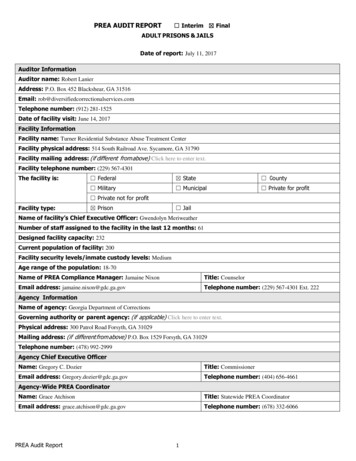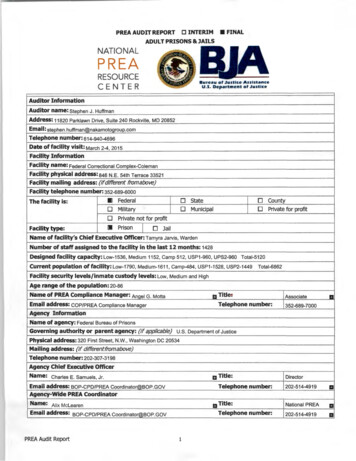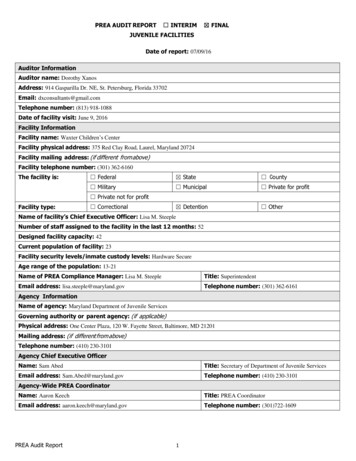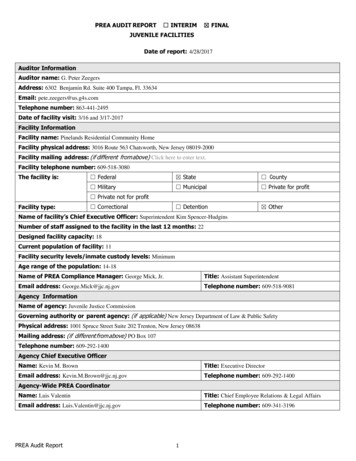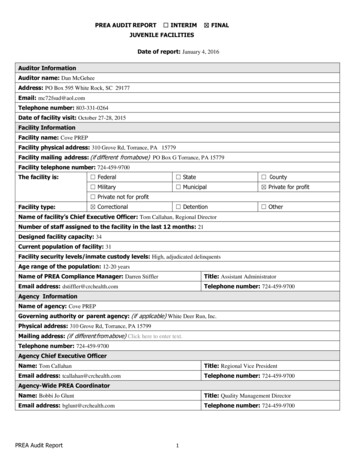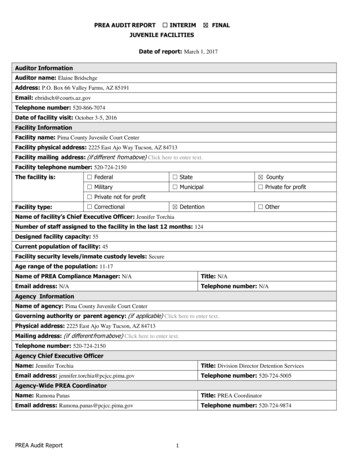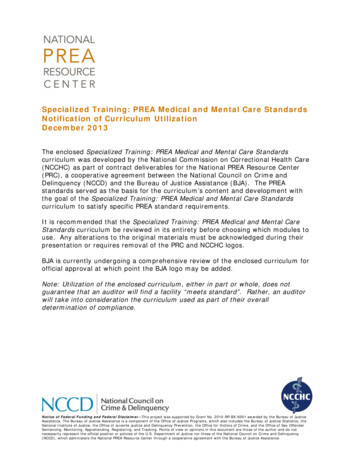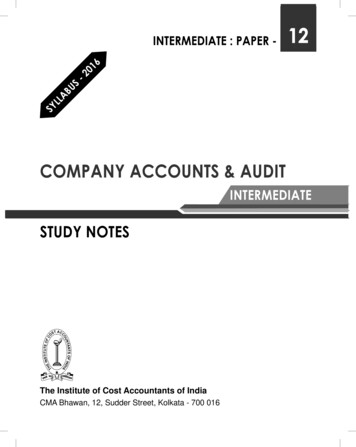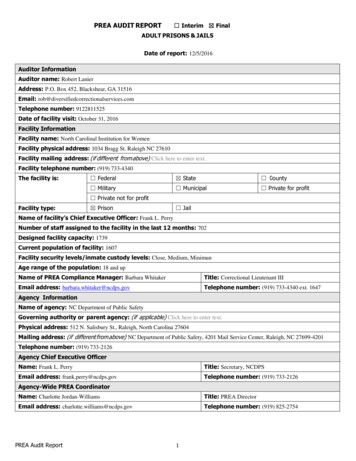
Transcription
PREA AUDIT REPORT Interim FinalADULT PRISONS & JAILSDate of report: 12/5/2016Auditor InformationAuditor name: Robert LanierAddress: P.O. Box 452, Blackshear, GA 31516Email: rob@diversifiedcorrectionalservices.comTelephone number: 9122811525Date of facility visit: October 31, 2016Facility InformationFacility name: North Carolinal Institution for WomenFacility physical address: 1034 Bragg St. Raleigh NC 27610Facility mailing address: (if different from above) Click here to enter text.Facility telephone number: (919) 733-4340The facility is: Federal State County Military Municipal Private for profit Private not for profitFacility type: Prison JailName of facility’s Chief Executive Officer: Frank L. PerryNumber of staff assigned to the facility in the last 12 months: 702Designed facility capacity: 1739Current population of facility: 1607Facility security levels/inmate custody levels: Close, Medium, MinimunAge range of the population: 18 and upName of PREA Compliance Manager: Barbara WhitakerTitle: Correctional Lieutenant IIIEmail address: barbara.whitaker@ncdps.govTelephone number: (919) 733-4340 ext. 1647Agency InformationName of agency: NC Department of Public SafetyGoverning authority or parent agency: (if applicable) Click here to enter text.Physical address: 512 N. Salisbury St., Raleigh, North Carolina 27604Mailing address: (if different from above) NC Department of Public Safety, 4201 Mail Service Center, Raleigh, NC 27699-4201Telephone number: (919) 733-2126Agency Chief Executive OfficerName: Frank L. PerryTitle: Secretary, NCDPSEmail address: frank.perry@ncdps.govTelephone number: (919) 733-2126Agency-Wide PREA CoordinatorName: Charlotte Jordan-WilliamsTitle: PREA DirectorEmail address: charlotte.williams@ncdps.govTelephone number: (919) 825-2754PREA Audit Report1
AUDIT FINDINGSNARRATIVEThe PREA Audit of the North Carolina Institution for Women, was conducted on October 31, 2016 through November 2,2016. Six weeks prior to the on-site audit the Notice of PREA Audit was forwarded to the facility for posting in areasthroughout the facility and grounds where it would be accessible to staff, inmates, contractors, interns and volunteers. Theauditor received one anonymous letter and performed due diligence based on the information provided in the letter. Theletter indicated that inmates in a specific living unit were walking around scantily dressed or naked and getting into theshowers together and that staff were remiss in correcting that behavior. The auditor interviewed inmates from the dormwhere the alleged activity was occurring as well as two experienced staff who work in the unit. Inmates in the unit indicatedthat the activity was repulsive and that while older, more seasoned staff held the inmates accountable, newer, lessexperienced staff did not. The inmates related that the activity going on in the living unit was consensual and that no onewas coercing or forcing anything on anyone else. The auditor interviewed two of the “seasoned” staff. They indicated thatthis behavior does not occur on their “watch”, that they do not tolerate it and that they hold inmates accountable forinappropriate behavior. They also related that inmates do not walk around naked. They said that during the summer theyhad issues with inmates wanting to take their shirts off. They also related that when the women do try to get into theshowers with other inmates, they write them up. After doing due diligence relative to the anonymous letter the auditorinformed the PREA Compliance Manager and the Warden of the allegations. The Warden and PREA Compliance Mangeragreed to brief staff again on supervision of inmates and consistently applying the rules and provide the auditor withconfirmation that the staff were briefed and that shift supervisors would “drop in” unexpectedly to observe staff supervisionof inmates in the unit. Thirty (30) days prior to the on-site audit the facility forwarded a flash drive with the agency’s andfacility’s policies, procedures, and supporting documents enabling the auditor to begin to understand the operations of theDepartment and the Prison. By prior agreement the auditor arrived at the facility around 7:30 AM. At 8:00 AM the auditormet briefly with the Deputy Warden and then the PREA Compliance Manager. A brief meet and greet was conducted to meetkey staff from the facility and to briefly explain the audit process. Following the entrance briefing the auditor took a tour ofthe entire facility accompanied by the PREA Compliance Manager and another Lieutenant who is soon to be the facility’sPREA Compliance Manager.PREA Audit Report2
DESCRIPTION OF FACILITY CHARACTERISTICSThis prison complex is huge and complex in that it houses over 1600 inmates and provides multi-faceted programs serving avariety of custody levels and needs.The North Carolina Correctional Institution for Women (NCCIW), in Raleigh, is the state’s major correctional facility forwomen. It houses the largest inmate population in the state and serves as the support facility for the state’s other six femaleprisons. The campus-style facility sits on 30 acres of a 190-acre tract of state land in southeast Raleigh.NCCIW houses female inmates all custody levels and control statuses including death row, maximum, close, medium,minimum and safe keepers. It provides the primary medical, mental and alcohol and chemical dependency treatment forfemale inmates.The facility operates a diagnostic center that serves as the point of entry into the prison system for all women sentenced asfelons. Upon arrival, inmates undergo a series of diagnostic evaluations that will determine future prison assignments.ProgramsCorrection Enterprises license tag plantCorrection Enterprises duplicating and quick copy plantDental labNC Travel and Tourism Information CenterReupholster shopGEDOffice technologyCosmetologyHorticultureCulinary artsMothers and Their Children (MATCH)Drug Alcohol Recovery Treatment (DART)Prisoners may attend worship services in the Chapel of the Nameless Woman and participate in Bible studies or otherreligious programs offered by prison chaplains, Prison Fellowship and other religious volunteers and organizations.HistoryThe prison originally served as a road camp for male inmates who worked on highway projects. Women inmates weretransferred to the Bragg Street site in 1933, while women’s living quarters at Central Prison were under renovation. Inmateswere initially housed in two large double-tier, barrack style cell blocks. Each building was designed to accommodate 160inmates. Other buildings on the site were a dining hall, converted infirmary, auditorium and administration building.Rather than return women inmates to Central Prison, the State Highway and Public Works Commission announced plans inthe mid-1930s to begin the construction of a women’s prison on the cottage plan in the immediate future. The project neverPREA Audit Report3
got beyond the planning stage. The prison eventually supported a farming and canning operation which continued throughthe 1950s.Central Prison administrators managed the prison until 1938, when the women’s prison became a wholly separate andindividual institution. In 1942, Mrs. Edna B. Strickland was named superintendent of the women’s prison becoming thestate’s first female prison superintendent. In 1996, the superintendent’s position was elevated to that of warden and CarolCaldwell became the first female warden in the state’s history.The first improvements to the old road camp prison were made in the late 1940s and early 1950s. A 1 million constructionprogram added four cottage style dormitories, an auditorium, segregation unit, sewing plant, cannery, laundry, kitchen anddining hall and administration building.In 1986, an aggressive construction and renovation plan for NCCIW began with the funding for a 28-bed infirmary andoutpatient medical services building. Over the next seven years, lawmakers funded approximately 25 million to replace orrenovate deteriorated buildings and as part of the prison’s master plan add buildings and support services necessitated byinmate population growth. Construction at the prison has continued into the 1990s. The funded master plan included sixnew dormitories, mental health facility, 48-cell maximum security building, operations building and gatehouse, securityperimeter fence and lighting, as well as other infrastructure and support services construction and renovations.PREA Audit Report4
SUMMARY OF AUDIT FINDINGSThe auditor’s methodology for conducting the PREA Audit of the North Carolina Correctional Institution for Women inRaleigh, North Carolina was as follows. Prior to the audit the facility received and posted the Notice of PREA Audit enablingstaff, inmates, volunteers, contractors, visitors and interns to communicate any PREA related concerns to the auditor. Theauditor received one anonymous letter and conducted due diligence to respond to the concern expressed. Due diligence wasconducted by interviewing inmates from a specific living unit and staff working in that dorm, after which the warden andPREA Compliance Manger were advised of the nature of the issue and potential actions they could take. The auditor receivedthe flash drive containing policies, procedures, forms and supporting documentation 30 days prior to the on-site audit. Theauditor thoroughly reviewed the information provided. Additional documentation was requested for the on-site auditreview. The requested information was provided and reviewed. The auditor toured the facility (see below) and observedinteractions between inmates and staff and inmates and inmates. Additionally, the auditor observed potential blind spotsthat were out of camera view. Informal interviews, with both staff and inmates, were conducted during this tour that lastedfrom 8:00AM through 3:30PM with no breaks. Informal interviews were conducted with custody staff, specialized categorystaff and maintenance staff. The auditor also interviewed large samples of both staff and inmates, randomly selected. A totalof 26 specialized staff were interviewed along with twenty-two (22) randomly selected staff. Also interviewed were nineteen(19) randomly selected inmates representing all housing units. An additional four inmates refused to be interviewed.Following the interviews the auditor sat down with the PREA Compliance Manager and her alternate to review additionalPREA related documentation. An exit was conducted with the Warden, PREA Compliance Manager and alternate. Additionaldocumentation was requested and provided.TourThis facility houses all custody levels of inmates, including death row inmates. Beginning in the administrative area, the tourcontinued through the medical/mental health complex, every living unit and dorm, all educational and vocational areas, foodservices and the minimum custody housing program outside the main prison complex. The facility was observed to be cleanand orderly and staff were observed maintaining observation and supervision of inmates in their areas. It was obvious duringthe tour that the facility has worked hard to identify blind spots and areas for potentially clandestine sexual activity. Thefacility has a number of offices and areas and doors with windows allowing easy viewing by anyone walking by or conductingunannounced PREA rounds. These windows were observed in virtually every living unit. Cameras were observed locatedthroughout the facility in strategic areas. Cameras were observed in the Robin Unit/Healthcare Unit stairwells and in theelevator. Mirrors have been used to mitigate vision in areas that did not have cameras. Again, it is evident that the facility isconcerned about enhancing supervision using cameras and the facility has a large number of cameras.In the Vocational Area/ Tag and Duplicator area, there is a set of stairs leading up to the “air handling Units.” This areahousing the air handling units contained multiple blind spots. Interviewed maintenance staff were not aware of who all hadaccess to the keys to the area. Hopefully cameras can be allocated to cover this area. It was noted however that the facilitydoes have a sign on a chain that should have been placed across the stairs that stated “No Inmates Allowed.” The facilitysubmitted documentation to confirm they will ensure the “No Inmates Allowed” sign remains up. Too, in the facility’sevaluation of options, they decided that they will add two mirrors to the Air Handler area over the tool room and adding onein the front office area. Too, the facility removed some boxes of air filters that were obstructing views. Additionally, thewarden provided a memo stating that in the upgrades of the video system he will also consider the feasibility of placingcameras in that area. Staff will also, when making unannounced rounds, check that area as well.A” canteen” storage unit was being used by two inmates to stock the shelves with goods that will be sold to the inmates. Thelights were out and visibility inside the unit with the lights out restricts and seriously limits viewing inside. The door was openand nothing inappropriate was observed other than the lights were out. The touring team agreed that one possible solutionthat was not costly would be to add motion detector lights in the canteen. As corrective action, the facility provideddocumentation that they have submitted a work order to install motion sensor lights.The warehouse area had no cameras however the post is gender specific and the post is occupied for one and one-half hoursafter the inmates working in the unit are gone.PREA Audit Report5
A solid wooden door in the hall (supply closet) needed a mirror to enable viewing and a window was observed covered witha sheet restricting viewing. The sheet was removed. The storage door #6 in this area was slightly obstructed by boxes stackedup past the window. Staff just need to be reminded not to stack boxes so high that viewing from the outside the area is notobstructed. Corrective action documentation confirmed that the sheet has been removed and the stacked -up boxes havebeen rearranged to clear the obstruction.Dorm E has no cameras in the basement area which is used only as a storage area for different units at the facility. The key tothe basement door is accessible to the staff on duty and the post is gender specific. Doors to specific rooms used for storageare secured with padlocks. Each unit using dedicated rooms for storage has a key to their specific room. This area is notaccessible to inmates however the facility agreed to consider, in the video upgrade plan, to consider the feasibility of placingcameras in this location.The acute side stairwell by the emergency exit needs minimally a mirror and preferably a camera.There is a blind spot at the chronic side stairwell at the A-2 Door. The facility provided documentation to confirm a workorder has been submitted for the mirrors.Inmates are afforded privacy during showers and when using the toilet. Every shower in the facility had PREA Curtains andtoilets had stalls with doors.Staff reported there were no cameras in any of the rooms except in the Robin Medical Unit where two cells were designatedfor monitoring inmates who exhibited “suicide potential”. Commodes in the rooms are in view of the camera. When askedabout this viewing staff related the rooms will be used for monitoring potentially suicidal inmates however the postobserving and monitoring the cameras would always be a female staff and would never be manned by a male staff. OnDecember 6, 2016, the facility provided the revised POST Order specifying that this post is gender specific.The auditor observed multiple occasions where opposite gender as well as same gender staff would announce the presenceof a male on the hall. Male announcements were loud and clear and left no doubt that a male was coming on the hall. Staffwere observed engaging inmates and inmates were observed to be well behaved.PREA Posters were observed throughout the facility and virtually every unit had a PREA Bulletin Board and other BulletinBoards were also replete with a variety of PREA Information. Bulletin Boards were often prominent and attractivelydecorated, drawing attention to the information on the boards. Information on the bulletin boards was posted in ways thatwere just very creative and attention drawing. Hotline numbers were observed posted prominently by or adjacent to thephones and inmates were observed using phones indicating that have access to them as needed.Nineteen (19) inmates from virtually every living unit were informally interviewed during the tour. All the inmates reportedreceiving PREA Training, including the Zero Tolerance Policy and how to report sexual abuse if it happened to them orsomeone they knew. They also related that information is readily available on bulletin boards. When asked if they had accessto the phones if they needed to call the hotline each of them stated that had no issues using the phones. Six of the 19informally interviewed inmates complained that inmates were using PREA allegations just to get moved to another unittrying to get in the same units as their “girlfriends” or to get someone moved, and they resented that they get moved. Iexplained the process and that we had to take every allegation seriously and take immediate action to protect the inmateswhile the facility conducts an investigation. They said they understood but felt it was not right. One inmate who had been inthe facility for decades came up to the auditor and thanked the auditor for PREA and for trying to help inmates remain safein the facilities. She related that staff at this prison take allegations seriously and she felt staff would take immediate action ifthere was an actual or alleged sexual assault. An additional 23 randomly selected inmates were selected to be interviewed.Four inmates refused to be interviewed even after the auditor attempted to explain the purpose of the interview and howthey might be helping other inmates in the future.Twenty-three (23) staff also were informally interviewed during the tour. These staff represented multiple living units andprograms. Staff were very knowledgeable of PREA and could articulate not only what they learned about PREA but also howand when they received their training. Twenty-two (22) randomly selected staff were also interviewed as well as staffaccounting for twenty-six (26) specialized categories of staff.PREA Audit Report6
Solid doors to closets and storage rooms that are not covered by a camera often had signs restricting access to authorizedpersonnel. Additionally, some of the keys to these areas were restricted keys that would require staff accessing the keys tocheck the keys out from the control room and sign for them, leaving a record of who has accessed the keys. Additional soliddoors out of camera view were identified during the tour that need signs on them restricting access. These doors werechecked however and were locked as they are required to be to prevent unauthorized access.Number of standards exceeded: 0Number of standards met: 43Number of standards not met: 0Number of standards not applicable: 0PREA Audit Report7
Standard 115.11 Zero tolerance of sexual abuse and sexual harassment; PREA Coordinator Exceeds Standard (substantially exceeds requirement of standard) Meets Standard (substantial compliance; complies in all material ways with the standard for therelevant review period) Does Not Meet Standard (requires corrective action)Auditor discussion, including the evidence relied upon in making the compliance or non-compliancedetermination, the auditor’s analysis and reasoning, and the auditor’s conclusions. This discussionmust also include corrective action recommendations where the facility does not meet standard. Theserecommendations must be included in the Final Report, accompanied by information on specificcorrective actions taken by the facility.The PREA Policies of the North Carolina Department of Public Safety (DPS) are comprehensive, well written and describe theagency’s Zero Tolerance Policy for any form of sexual activity including sexual abuse, misconduct, sexual harassment andretaliation for reporting sexual abuse or sexual harassment. The agency has demonstrated its commitment to PREA byappointing an Agency PREA Director and a PREA Coordinator for secure facilities and by promulgating very detailed andcomprehensive policies and procedures. The agency’s PREA Policy and other relevant DPS Policies describe a comprehensiveand integrated approach to prevention, detection, responding and reporting to allegations of sexual abuse and actual sexualabuse. A brief interview with the PREA Coordinator indicated that he is a very professional and very knowledgeableindividual who has been involved in implementing PREA for a number of years. Additionally, the Warden has designated aLieutenant as the PREA Compliance Manager. The PREA Compliance Manger at the North Carolina Correctional Institutionfor Women is one of the most knowledgeable and motivated PREA Compliance Managers I have had the pleasure of workingwith. She is not only aware of the standards but is totally aware of what is going on in her prison. She is aware not only ofthe standards ,but also of facility blind spots and how the agency has addressed them. She also has an associate PREACompliance Manager in training. He is a highly motivated young man and can be expected to do a good job as well. ThePREA Compliance Managers have sufficient time and authority to coordinate the facility’s efforts to comply with the PREAstandards. The PREA Compliance Manager related that she has the complete support of the prison’s administration inimplementing PREA. Interviews with staff confirmed that they have been trained in and understand the agency and facilityhas a zero tolerance for all forms of sexual activity and sexual harassment. Interviews with multiple inmates representingevery living unit, including those informally interviewed during the tour as well as those randomly selected, also indicatedthat they are informed of and understand that there is a zero tolerance for all forms of sexual activity and sexualharassment. Reviewed acknowledgments also confirmed that staff, inmates and volunteers are trained in and understandthe zero tolerance policy.Standard 115.12 Contracting with other entities for the confinement of inmates Exceeds Standard (substantially exceeds requirement of standard) Meets Standard (substantial compliance; complies in all material ways with the standard for therelevant review period) Does Not Meet Standard (requires corrective action)Auditor discussion, including the evidence relied upon in making the compliance or non-compliancedetermination, the auditor’s analysis and reasoning, and the auditor’s conclusions. This discussionmust also include corrective action recommendations where the facility does not meet standard. Theserecommendations must be included in the Final Report, accompanied by information on specificcorrective actions taken by the facility.The facility does not contract for the confinement of inmates.PREA Audit Report8
Standard 115.13 Supervision and monitoring Exceeds Standard (substantially exceeds requirement of standard) Meets Standard (substantial compliance; complies in all material ways with the standard for therelevant review period) Does Not Meet Standard (requires corrective action)Auditor discussion, including the evidence relied upon in making the compliance or non-compliancedetermination, the auditor’s analysis and reasoning, and the auditor’s conclusions. This discussionmust also include corrective action recommendations where the facility does not meet standard. Theserecommendations must be included in the Final Report, accompanied by information on specificcorrective actions taken by the facility.The staffing plan for the facility is developed by the Warden and his administrative team and documented in the Division ofAdult Correction-Prisons Post Chart. The post chart identifies the minimum requirements identified for staffing for each ofthe housing units, support services, operations and supervisory staff. The plan is based on the shift hours for positions, thenumbers of days covered with a minimum number of staff for each shift and using a relief factor to determine the totalnumbers of staff needed for each post. Additionally, the staffing plan identifies the “pull post levels” for each position. If thefacility cannot meet the minimum staffing posts are identified for “pulling”. Additionally, staff may be pulled from supportservices or staff may be held over to meet the minimum staffing. The staffing plan is submitted to the DPS Regional Officefor approval. The plan is reviewed annually by the Regional Office and the Division Office. Staffing analyses are conductedevery three years on site by a DPS team. The plan considers the items required by the standards and video monitoring isalways a part of the planning process to supplement direct supervision. This facility has a large number of cameras coveringnumerous blind spots. The Warden related plans to further upgrade the existing camera system by adding multipleadditional cameras to cover blind spots. Supervision is enhanced further by unannounced rounds made each shift by theshift supervisors. The Warden and his Deputy Warden conduct unannounced rounds as well. These rounds include checkingdoors to ensure that locked areas are locked and that staff and inmates are where they are supposed to be. Additionally,headcounts throughout the day and night account for the whereabouts of inmates and staff.Standard 115.14 Youthful inmates Exceeds Standard (substantially exceeds requirement of standard) Meets Standard (substantial compliance; complies in all material ways with the standard for therelevant review period) Does Not Meet Standard (requires corrective action)Auditor discussion, including the evidence relied upon in making the compliance or non-compliancedetermination, the auditor’s analysis and reasoning, and the auditor’s conclusions. This discussionmust also include corrective action recommendations where the facility does not meet standard. Theserecommendations must be included in the Final Report, accompanied by information on specificcorrective actions taken by the facility.North Carolina Department of Public Safety (NCDPS) Policy F.3400 (Inmate Sexual Abuse and Sexual Harassment), requiresthat youthful offenders are not placed in a housing unit in which the youthful inmate would have sight and sound contactwith any adult inmates using a shared dayroom or other common space, shower area or sleeping quarters. It also requiresthat in areas outside the housing units, the facility either maintains sight and sound separation between youthful inmatesand adults or provides direct staff supervision when youthful inmates and adult inmates have sight, sound, or physicalcontact. Additionally, the policy requires that youthful inmates have access to other programs and work opportunities to thePREA Audit Report9
extent possible. This facility houses youthful offenders in a self- contained unit that enables youthful inmates to be sight andsound separated from adult offenders. Youthful inmates are housed in single occupancy cells. There are five restrictedhousing cells (segregation). The unit has its own program area, rec yard and dining room. Inmates go to church while adultinmates are also attending however the youthful inmates are required to sit in the back of the chapel, separate from theadult prisoners and are supervised by two correctional staff. An interview with a youthful offender confirmed that youth arehoused in a self-contained unit, sight and sound separated from adult inmates. She also related that youth are providedopportunities for programming and access to medical and mental health inside the unit. There were six youthful offenders inthe unit during the on-site audit period.Standard 115.15 Limits to cross-gender viewing and searches Exceeds Standard (substantially exceeds requirement of standard) Meets Standard (substantial compliance; complies in all material ways with the standard for therelevant review period) Does Not Meet Standard (requires corrective action)Auditor discussion, including the evidence relied upon in making the compliance or non-compliancedetermination, the auditor’s analysis and reasoning, and the auditor’s conclusions. This discussionmust also include corrective action recommendations where the facility does not meet standard. Theserecommendations must be included in the Final Report, accompanied by information on specificcorrective actions taken by the facility.North Carolina Department of Public Safety Division of Prisons, Policy and Procedures, Chapter F .0100, OperationalSearches, requires that complete (strip searches) of inmates are conducted only by correctional officers of the same sex asthe inmate, except in exigent circumstances as determined by the shift supervisor. After conducting a complete search inexigent circumstances the staff conducting the search is required to submit an Incident Report explaining the urgencyjustifying the search exception. The DPS policy also prohibits searching a transgender or intersex inmate for the sole purposeof determining the inmate’s genital status. Cross gender strip, body cavity and frisk searches are not allowed absent exigentcircumstances. Interviewed staff indicated they were trained to conduct cross gender pat/frisk searches however theystated they have never seen a male officer conduct a frisk search of any inmate. Interviewed inmates representing allhousing units related that male staff do not search females. They related a male as never searched them nor have any ofthem ever witnessed a male staff conducting a search of a female.Showers were observed to provide privacy through use of PREA Curtains that a
It provides the primary medical, mental and alcohol and chemical dependency treatment for female inmates. The facility operates a diagnostic center that serves as the point of entry into the prison system for all women sentenced as felons. Upon arrival, inmates undergo a series of diagnostic evaluations that will determine future prison .
